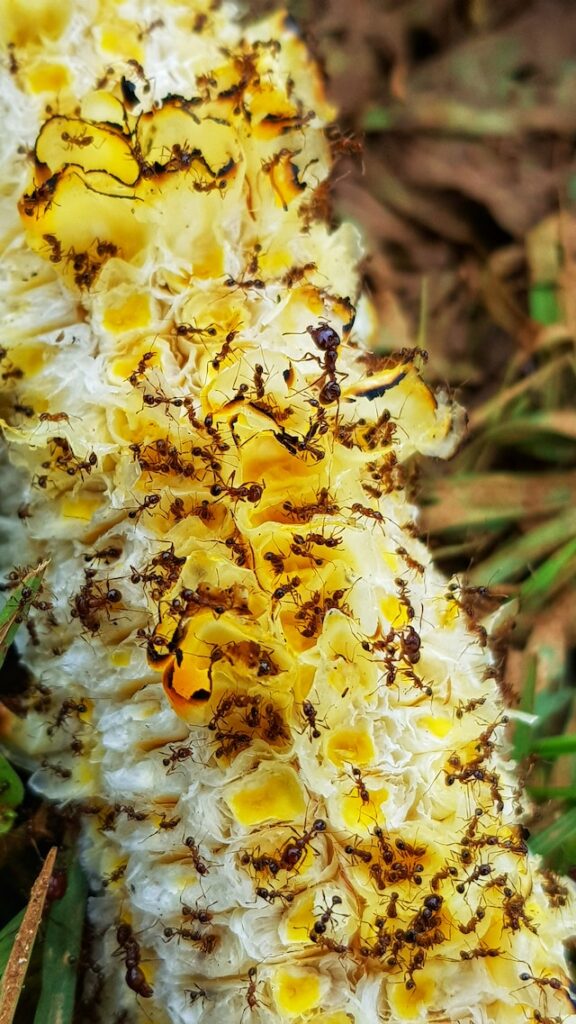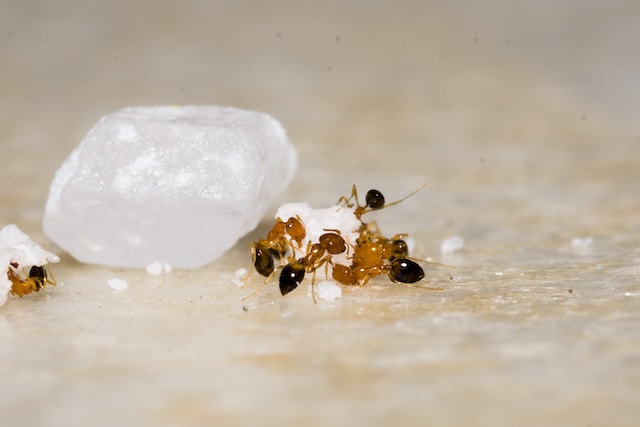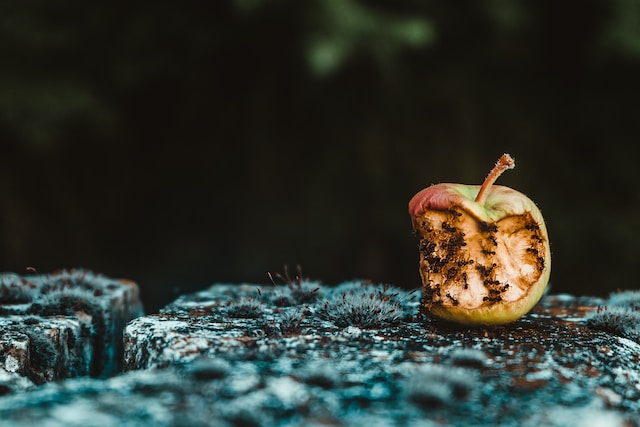Have you ever wondered how ants always locate food, no matter where it is? How do ants find food?
Whether scouring your kitchen for crumbs or foraging in the great outdoors, ants are always on the hunt for their next meal. These tiny creatures are true survivors, using their remarkable adaptability and efficient strategies to ensure the survival of their colony.
This blog will explore the world of ant behavior and their fascinating strategies for finding food. Whether you have a current ant infestation or want to know a few tips and tricks to keep them away, we’ll help you understand what attracts these pests and how to eliminate them!
How Ants Find Food in Your Yard
Ants are tiny creatures with an immense talent for discovering food. With a complex and highly organized system for foraging, they’ve evolved into incredible hunters.

Pheromone trails help ants pinpoint the location of food sources on your property. These invisible signals act like a roadmap for other ants to follow, leading them straight to the food source. As each ant follows the trail, they leave more pheromones behind, making it easier for future foragers to find the food.
They also use various communication methods to coordinate their efforts and share information. By working together, ants can efficiently locate and harvest food to bring back to their colony.
Ants are opportunistic predators, always on the search for their next meal. Their favorite target? Live insects like beetles, caterpillars, and aphids.
These creepy crawlies are like an all-you-can-eat buffet for ants, and your yard has an abundance of available insects ready for ants to consume.
But ants don’t stop at just insects. They also have a sweet tooth and are attracted to nectar, a sugary delight often available during spring and summer. While they may find sweet treats inside your home, the variety and abundance of nectar outdoors is simply too tempting for ants to ignore.
And let’s not forget about the sweet and sticky sap that flows from trees. Ants go crazy for this sugary goodness and often set up camp near trees t to take full advantage of this tasty treat. So if you have trees in your yard, beware – ants may be on the prowl!
How do Ants Find Food Indoors?
Your backyard isn’t the only ant hotspot! Indoor locations like our homes provide a plethora of indulgent options ants flock toward to consume. Here is how ants locate food inside:
- Scent: Ants have an excellent sense of smell, enabling them to detect food from afar. Using their antennae, they can sense the aroma of food and follow it to the source.
- Communication: As social insects, ants regularly communicate with one another indoors and outside. When one ant finds food, it releases pheromones that attract other ants to the source. This allows the colony to quickly gather many ants at the food source, maximizing efficiency.
- Adaptability: Don’t forget that ants are adaptable creatures and can survive in various environments. They locate food indoors by setting up shop inside or near cracks or crevices that lead indoors to accessible food sources.
Food availability is the prime reason why ants may come indoors. While ants can find nourishment outdoors, these alternatives may become scarce or unavailable at certain times of the year. When their outdoor food sources deplete, ants could turn to your pantry.
Their determination to find food primarily leads them straight into our homes. How do ants find food indoors, and where do these pests prefer to go?
While this one is a no-brainer, our kitchens with tasty snacks and ingredients are prime spots for ants to congregate. From sugary cereal to sticky honey, ants will make a beeline for any food left out on the counter or in the pantry.

While we may think of garbage as gross and unappetizing, ants see it as a treasure trove of food. Any food scraps or leftovers in the trash can are like a beacon to ants, drawing them in with the promise of a feast.
Believe it or not, ants may also nest inside electrical appliances like coffee makers and toasters. These appliances often contain small food crumbs and debris ants can feast on.
Ants are similarly attracted to moisture, and the damp environment of a bathroom drain can be the perfect spot for them to find food. Toothpaste, soap, and other personal care products contain ingredients that ants could find appealing.
No matter where they find food in our homes, ants are resourceful creatures that stop at nothing to get what they want. To safeguard your home and food, you should rely on proven pest control methods to keep these insects at bay.
Eliminating Ants Indoors with United States Pest Service
Luckily, you can do a few things to prevent ants from entering your home and raiding your pantry.
Keeping your home tidy and crumb-free is the first step for ant prevention. Ants are attracted to food particles, so sweeping your floors and wiping down your counters can keep these pesky insects at bay.
Ants can easily detect unsealed food containers, so store your food in airtight containers or in the fridge. This will not only keep ants out but will also help prolong your food’s shelf life.
Another effective method to keep ants away is to seal any potential entry points into your home, like cracks in your walls, doors, windows, and openings around pipes or wires. Ants are tiny creatures, so even the most minor gaps can provide an entry point for them.
Following these tips can create a barrier preventing ants from coming indoors and feasting at your expense. However, they can’t eliminate pests wholly. You must rely on professional pest control methods to keep them at bay!
Don’t let these pesky insects ruin your day – take action now with United State Pest Service, and keep them out of your home for good!

